There are dozens of ways to ruin a lemon meringue pie, and as I walked up to the French Pastry School’s Loop campus, I envisioned every single one of them.
I’d been invited to spend a few hours with Sébastien Canonne, the school’s cofounder. He has run this institution for 20 years, won the title of Meilleur Ouvrier de France (an award for outstanding artisans handed out in an annual competition), and was even named a knight of the French Legion of Honor. This is the guy who was supposedly going to teach me, a girl whose baking talents end at fruit crisps, how to make a restaurant-quality lemon meringue pie.
Canonne’s first piece of advice: “Relax.” I realized that my shoulders were up by my ears. “Anytime you feel uncomfortable, that’s usually when you will cut yourself or burn yourself.”
As I read through his four-page recipe, though, I couldn’t help feeling nervous. The sablé crust looked straightforward enough—it’s basically a giant cookie—but I’d never successfully made meringue before, and I saw that making the lemon curd required a double boiler, a tool I associated with second-degree burns thanks to a chocolate-melting mishap I’d rather not go into.
The master’s second piece of advice was to invest in top-quality ingredients: organic eggs, organic flour, and, most important, European-style butter, which has a higher fat content than American butter and thus less water, which turns to steam during baking.

And, Canonne stressed, suck it up and buy a kitchen scale—a good one that measures to the tenth of a gram. A scale is an insurance policy against unintentionally over- or underpacking a measuring cup or spoon.
With that, we got to work on our respective pies—me trying to mimic my mentor’s every move—starting with the crust. Canonne had placed the carefully measured ingredients in prep bowls, which he’d laid out in the order in which the ingredients would be added to the mixer. Order, I learned, is all-important. Take vanilla, which I usually forget until right before the end. It actually needs to be added to the highest-fat ingredient as early as possible so it can penetrate the fat molecules. Salt has to go in early, too, to extract extra moisture from the butter. Baking is like any other skill, Canonne told me; if you know the why as well as the how, you’re on the road to mastery.
Next we par-baked the crusts. Canonne’s, as might be expected, came out flawless. Mine, less so: Its edges were uneven, with unsightly flaps hanging over the aluminum tart pan.
Then came the lemon curd. Though I managed more or less successfully to mix the lemon juice and zest with the sugar, eggs, salt, and butter, the double boiler tripped me up once again. I overcooked the curd, resulting in discoloration once the curd was baked. I did better with the meringue—and learned that it’s crucial to clean your mixing bowls thoroughly after making the curd to remove all traces of fat.
I really got schooled, though, on the finishing touch. As Canonne piped the meringue, his steady-handed strokes were effortless; mine were stiff and uneven. Just look at the two pies in the photo above. Some things should be left to the pros.
How did mine taste? My curd almost matched the bright, tart flavor of Canonne’s, and my slightly misshapen and singed crust was good, as was the toasty-edged meringue. I beamed as my coworkers gleefully scarfed down the remainder of the pie back at the office.
Perfect? Not quite. Delicious? Definitely.
Creaming the butter on the lowest possible setting. (By hand works if you’re not feeling using a machine.)
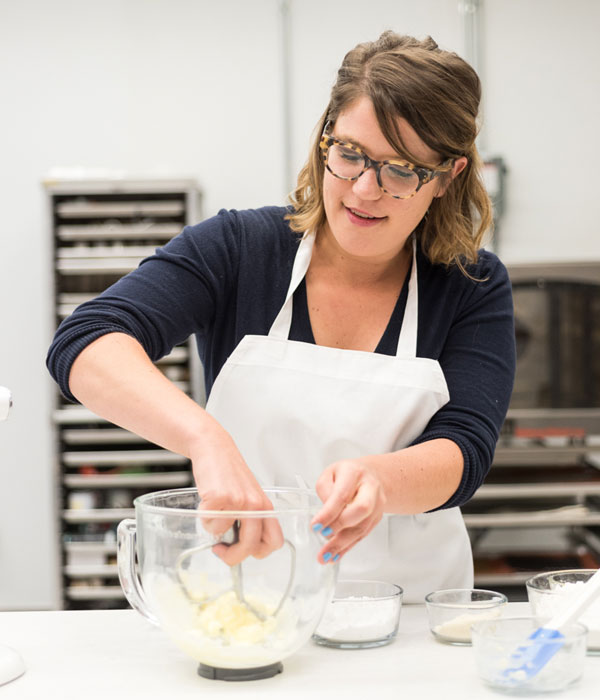
Scooping out the dough before its trip to the fridge.
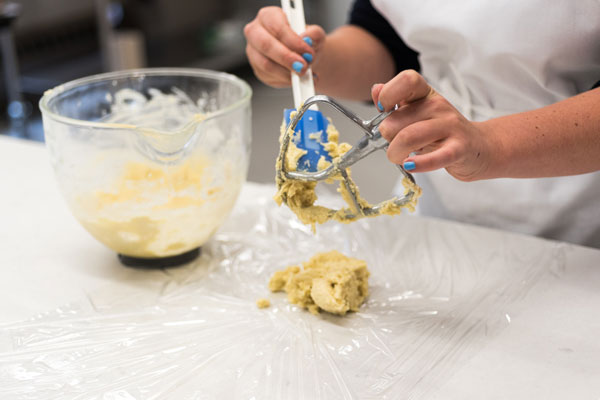
Rolling the dough out nice and thin is much easier with the assistance of a French pastry master.
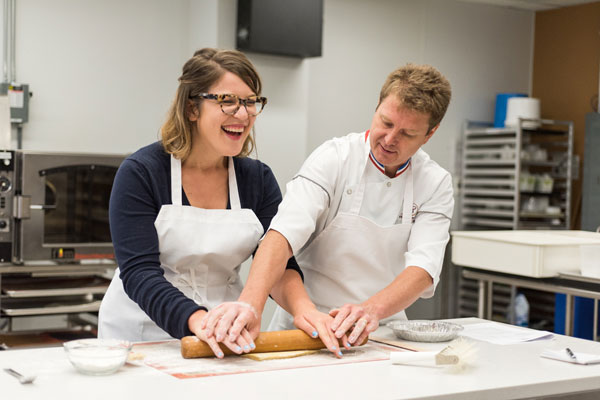
Gently setting the dough into the pie shell.
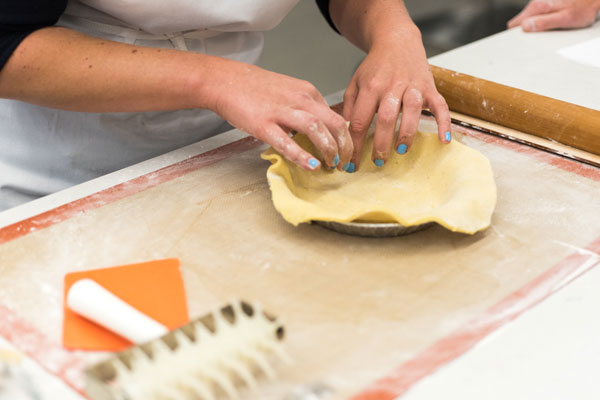
A second round of stabbing the dough with the fork, pastry’s best stress reliever.
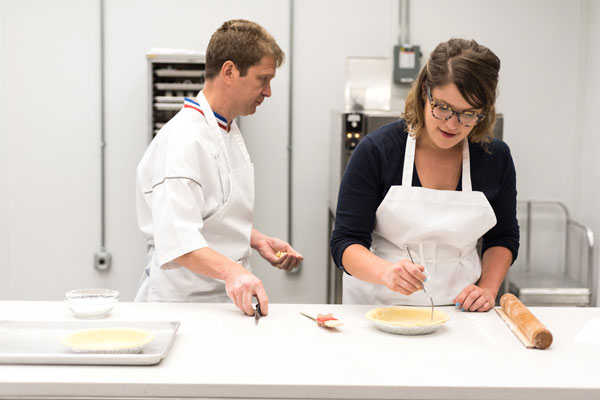
Waiting. So much waiting.
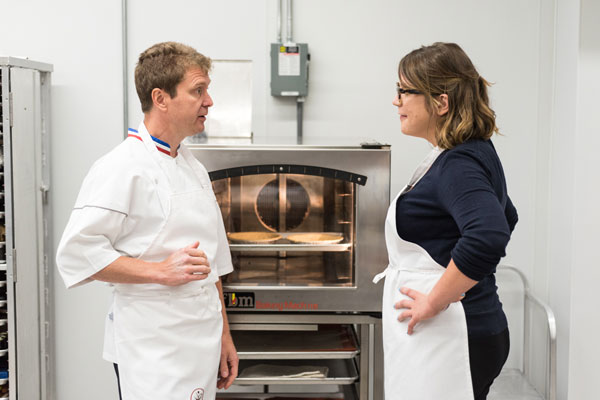
The master and the novice’s work, side-by-side. My inexperience begins to show.
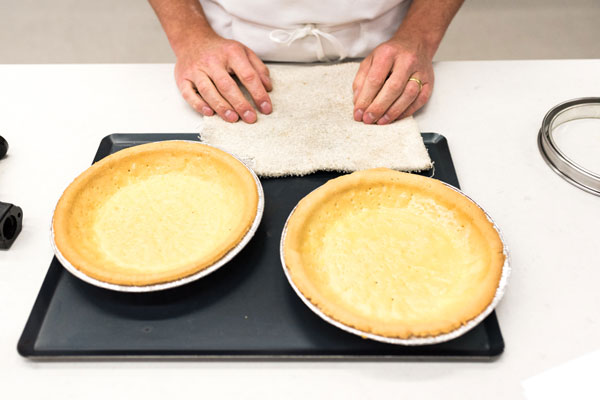
Curd time! The endless whisking is more fun when you have a laser thermometer to play with as you go.
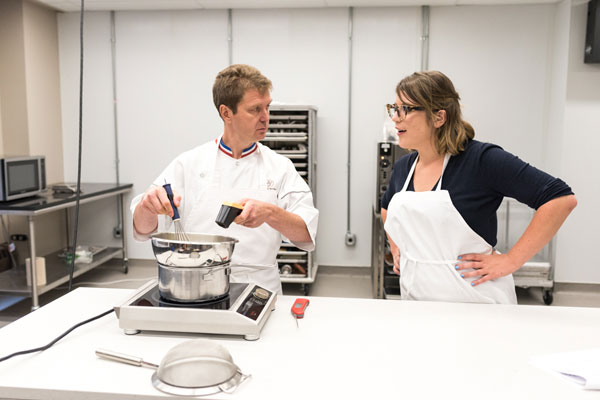
Straining for chunks. Canonne’s curd had none. Mine had…plenty.

I begin to pipe in a manner I’d affectionately refer to as “rustic.”
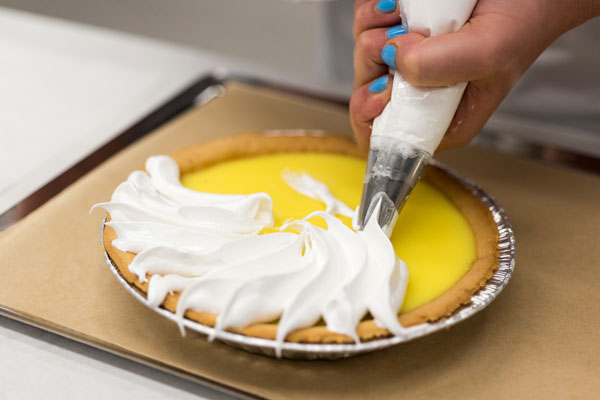
A final trip to the oven.
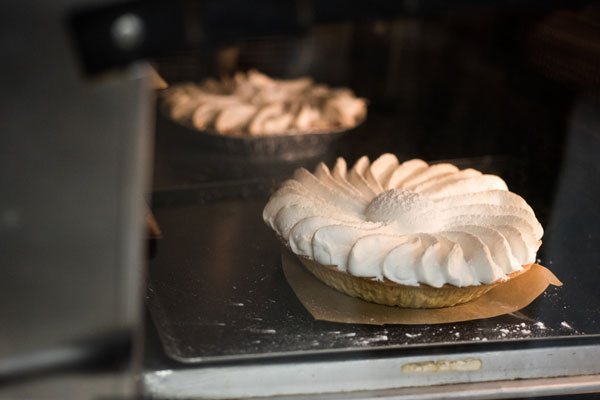
The Recipe
Canonne stresses that all ingredients should be measured as precisely as possible and allowed to come to room temperature before you start.
Egg Wash
Ingredients
| 1 Tbsp. plus 1 tsp. | egg yolk (from 1 extra-large egg—see note) |
| 1/8 tsp. | fine sea salt |
| 1 tsp. | heavy cream |
Method
Mix all ingredients and push through a strainer. Set aside.
Pie Shell
Ingredients
| 1/2 cup plus 1 tsp. | unsalted butter |
| 1/2 tsp. | fine sea salt |
| 1 tsp. | vanilla extract |
| 1/2 cup plus 2 Tbsp. | confectioners’ sugar, sifted |
| 1/4 cup plus 2 1/2 tsp. | almond powder |
| 3 Tbsp. plus 2 tsp. | egg yolks (from 3 extra-large eggs) |
| 1 1/2 cups | all-purpose flour |
Method
1 Heat oven to 285 degrees. 2 In the bowl of a standing mixer, cream the butter, salt, and vanilla using the paddle attachment on the lowest speed.
3 Add in the confectioners’ sugar and almond powder, followed by the egg yolks and half of the flour. Mix.
4 Add the rest of the flour and mix until a dough forms.
5 Divide the dough in half and wrap each half with plastic wrap. Chill one of the halves for at least 2 hours, preferably overnight. Place the other in the freezer for a future pie.
6 Roll the refrigerated dough out to 1/8 of an inch, then pierce the surface with a fork.
7 Line a greased aluminum pie pan with the dough (pierced side down), then pierce the top of the dough with the fork.
8 Trim excess dough using a small paring knife, then place pie shell in the fridge until firm, about 30 minutes.
9 Par-bake the shell for 18 to 20 minutes, or until light golden in color.
10 Remove from the oven, let cool to room temperature, and brush with a thin layer of egg wash. (See recipe at left.)
11 Return the pie shell to oven for 10 to 12 minutes, until it becomes a deeper gold.
12 Remove from the oven and place on a cooling rack.
Lemon Curd
Ingredients
| Zest of 3 lemons | |
| 3/4 cup | freshly squeezed lemon juice |
| 1/2 cup plus 2 1/2 tsp. | granulated sugar |
| 1 cup plus 3 Tbsp. plus 2 tsp. | whole eggs (6 extra-large eggs) |
| 1/8 tsp. | fine sea salt |
| 3 Tbsp. | unsalted butter |
Method
1 Heat oven to 285 degrees.
2 Whisk all ingredients in a large mixing bowl.
3 Lower bottom of bowl into a pot of simmering water and heat until the mixture registers 140 degrees on a candy thermometer.
4 Immediately strain the mixture and pour into the prebaked pie shell.
5 Bake for 10 to 12 minutes, or until set.
6 Place the pie on a cooling rack for about 15 minutes, then refrigerate until ready to serve.
Meringue
Ingredients
| 1/4 cup plus 1 Tbsp. | egg whites (from 3 extra-large eggs) |
| 3/4 cup | granulated sugar |
| 1/4 tsp. | fine sea salt |
| Confectioners’ sugar, for dusting |
Method
1 Heat oven to 420 degrees.
2 In a medium saucepot, bring 2 to 3 inches of water to a simmer, then turn the burner off.
3 Put all ingredients into the bowl of a stand mixer and mix by hand with a whisk.
4 Lower the bottom of the mixing bowl into the pot of water. Whisk constantly until the mixture reaches 122 degrees on a candy thermometer.
5 Transfer the bowl to the stand mixer and whip on high speed until the meringue is firm and fluffy.
6 Fit a pastry bag with a St. Honore decorating tip and fill with meringue. Using slightly curved strokes, pipe from the center to the edge and repeat, leaving a circular space in the center about 1 inch in diameter. When the perimeter of the pie is covered, fill in the remaining space with a piped mound of meringue.
7 Dust with confectioners’ sugar and set aside for about 3 minutes.
8 Dust again and bake for about 3 minutes, or until meringue starts to turn toasty brown. Let pie rest for 2 hours before serving.
NOTE: Don’t freak out that the egg quantities are expressed by volume rather than number—it’s all in the name of precision. We suggested the minimum number of eggs necessary to yield the required amount.


